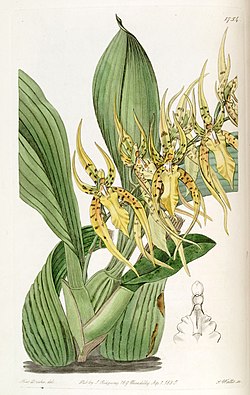| Lance's brassia | |
|---|---|
 | |
| 1836 illustration Edwards's Botanical Register | |
| Scientific classification | |
| Kingdom: | Plantae |
| Clade: | Tracheophytes |
| Clade: | Angiosperms |
| Clade: | Monocots |
| Order: | Asparagales |
| Family: | Orchidaceae |
| Subfamily: | Epidendroideae |
| Genus: | Brassia |
| Species: | B. lanceana |
| Binomial name | |
| Brassia lanceana Lindl. (1835) | |
| Synonyms [1] | |
| |
Brassia lanceana, or Lance's brassia, is a species of orchid. It is native to Trinidad & Tobago, Venezuela, Guyana, Suriname, French Guiana, Colombia, Panama, Ecuador, Peru and northern Brazil. [1]